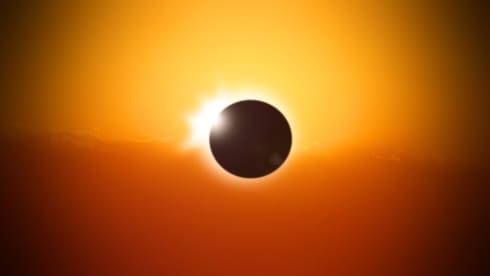When the moon hits your eye … or something like that! Needless to say, we’re excited about the solar eclipse, set to take centre stage on Monday, August 21, but want to ensure we enjoy this once-in-a-lifetime event safely. That said, we asked the experts at the Canadian Ophthalmological Society (COS) to share their top tips for viewing—alone or with kiddies—this incredible natural phenomenon. —Noa Nichol
What is a solar eclipse?
A solar eclipse is a celestial event in which the moon passes between the sun and earth and blocks all or part of the sun for up to about three hours. A shadow will fall on earth during this time. For the event on August 21, Canadians will experience a once-in-a-lifetime event and view part of a total solar eclipse as it passes over North America.
(Editor’s note: A lunar eclipse occurs when the earth passes between the moon and the sun, and the earth’s shadow obscures the moon or a portion of it. As explained above, a solar eclipse occurs when the moon passes between the earth and the sun, blocking all or a portion of the sun. The fact that the August 21 solar eclipse is a total eclipse, meaning that the moon will completely block the sun, makes it very special!)
Who in Canada will be able to view/experience it?
Canadians will experience a partial eclipse, meaning the moon, sun and earth will not align in a perfectly straight line, preventing full coverage of the sun. Even though Canadians won’t be in the path of totality, it’s important to have safe viewing practices in place to prevent damage to the eyes. Harmful effects can take place when the bright light from the sun floods the retina on the back of the eyeball.
The luckiest Canadians will be those living on the West Coast. Residents in Victoria will have the best views with 90 per cent of the sun blocked out. Vancouver and Calgary will both see 80 per cent coverage, while other cities, including Toronto, Edmonton and Regina will enjoy 70 per cent. Atlantic Canada will see less of the eclipse, with Halifax receiving only 50 per cent coverage.
The date to save is August 21, but is there a specific time we should be carefully "looking up"?
Visibility will differ throughout the country, but will begin on the West Coast at 9 a.m. (PST). With the eclipse travelling east, Calgarians will spot the coverage a little after 10 a.m. (MST), followed by Edmonton and Regina at 10:30 a.m. (MST). Toronto will see the first glimpse of the eclipse at 1:10 p.m. (EST) and will continue to make its way toward the East Coast and Halifax by 2:40 p.m. (ATD).
It’s never safe to look directly at the sun without protective eyewear; doing so can cause a lifetime of permanent damage, otherwise known as “solar retinopathy”. On August 21, it is even more important for Canadians to wear eye protection in the form of special-purpose solar filters (ask whether your local museum or science centre carries these).
Would any weather conditions impact viewing/visibility that night?
The weather forecast plays a huge part in visibility. Overcast skies in any location will affect the impact of the experience for Canadians.
What can we expect to see?
As the eclipse travels across Canada, there is no part of country where the sun will be completely eclipsed. With that said, the sky will be dimmed. At 90 to 80 per cent coverage, which Canadians in Victoria and Vancouver will witness, a thin slit of sunlight will remain visible. In other regions a shadow will be cast as the atmosphere becomes darker, but slightly less in areas with lower coverage.
Top tips for optimal and safe viewing?
COS asserts the only safe way to look directly at a total or partial eclipse is with special-purpose solar filters. “Viewing even the smallest sliver of a crescent sun peeking out from behind the moon is enough to possibly cause irreversible damage to your vision,” says ophthalmologist Dr. Setareh Ziai. “Everyone should be able experience this celestial event, however it is important to view the phenomenon safely.”
Safe:
> Viewing the eclipse with specially designed solar eclipse glasses or viewers to block the sun’s harmful rays.
> Using specially designed filters for lenses, e.g., cameras, binoculars, telescopes and other optical devices. Looking through a telescope, a camera or binoculars alone does not protect your eyes against the possible damage from a solar eclipse. You must wear your protective eyewear (or specialized filters marked with ISO 12312-2) for these devices) before viewing the eclipse through the device.
Not Safe:
> Looking directly at the eclipse without eye protection.
> Using ordinary sunglasses since they are not strong enough to protect your eye.
Any tips specific to kids?
“Children of all ages should always be supervised when viewing an eclipse”, says Dr. Ziai. “It’s also important for adults to remind children that they should never look directly at the sun, except during totality (when the sun is fully eclipsed) since it can cause harmful damage. Canadians will only be able to view a partial eclipse, but it’s still very important to have safe solar viewing options available and explained in advance so children understand how the tools are to be used. The viewing should be a fun event that will be memorable for children at any age.”





Be the first to comment